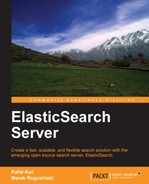Welcome to the ElasticSearch Server book. While reading this book, you will be taken on a journey to the wonderful world of full-text search provided by ElasticSearch enterprise search server. We will start with a general introduction to ElasticSearch, which covers how to start and run ElasticSearch and how to configure it using both configuration files and the REST API. You will also learn how to create your index structure and tell ElasticSearch about it, how to configure different analyses for fields, and how to use the built-in data types.
This book will also discuss the query language, the so-called Query DSL, that allows you to create complicated queries and filter returned results. In addition to all that, you'll see how you can use faceting to calculate aggregated data based on the results returned by your queries. We will implement the autocomplete functionality together and will learn how to use ElasticSearch's spatial capabilities and how to use prospective search.
Finally, this book will show you some capabilities of the ElasticSearch administration API, with features such as shard placement control, cluster handling, and more. In addition to all that, you'll learn how to overcome some common problems that can come up on your journey with ElasticSearch server.
Chapter 1, Getting Started with ElasticSearch Cluster, covers ElasticSearch installation and configuration, REST API usage, mapping configuration, routing, and index aliasing.
Chapter 2, Searching Your Data, discusses Query DSL—basic and compound queries, filtering, result sorting, and using scripts.
Chapter 3, Extending Your Structure and Search, explains how to index data that is not flat, how to handle highlighting and autocomplete, and how to extend your index with things such as time to live, source, and so on.
Chapter 4, Make Your Search Better, covers how to influence your scoring, how to use synonyms, and how to handle multilingual data. In addition to that, it describes how to use position-aware queries and check why your document was matched.
Chapter 5, Combining Indexing, Analysis, and Search, shows you how to index tree-like structures, use nested objects, handle parent-child relationships, modify your live index structure, fetch data from external systems, and speed up your indexing by using batch processing.
Chapter 6, Beyond Searching, is dedicated to faceting, "more like this", and the prospective search functionality.
Chapter 7, Administrating Your Cluster, is concentrated on the cluster administration API and cluster monitoring. In this chapter you'll also find information about external plugin installation.
Chapter 8, Dealing with Problems, will guide you through fetching large results sets efficiently, controlling cluster rebalancing, validating your queries, and using warm-up queries.
